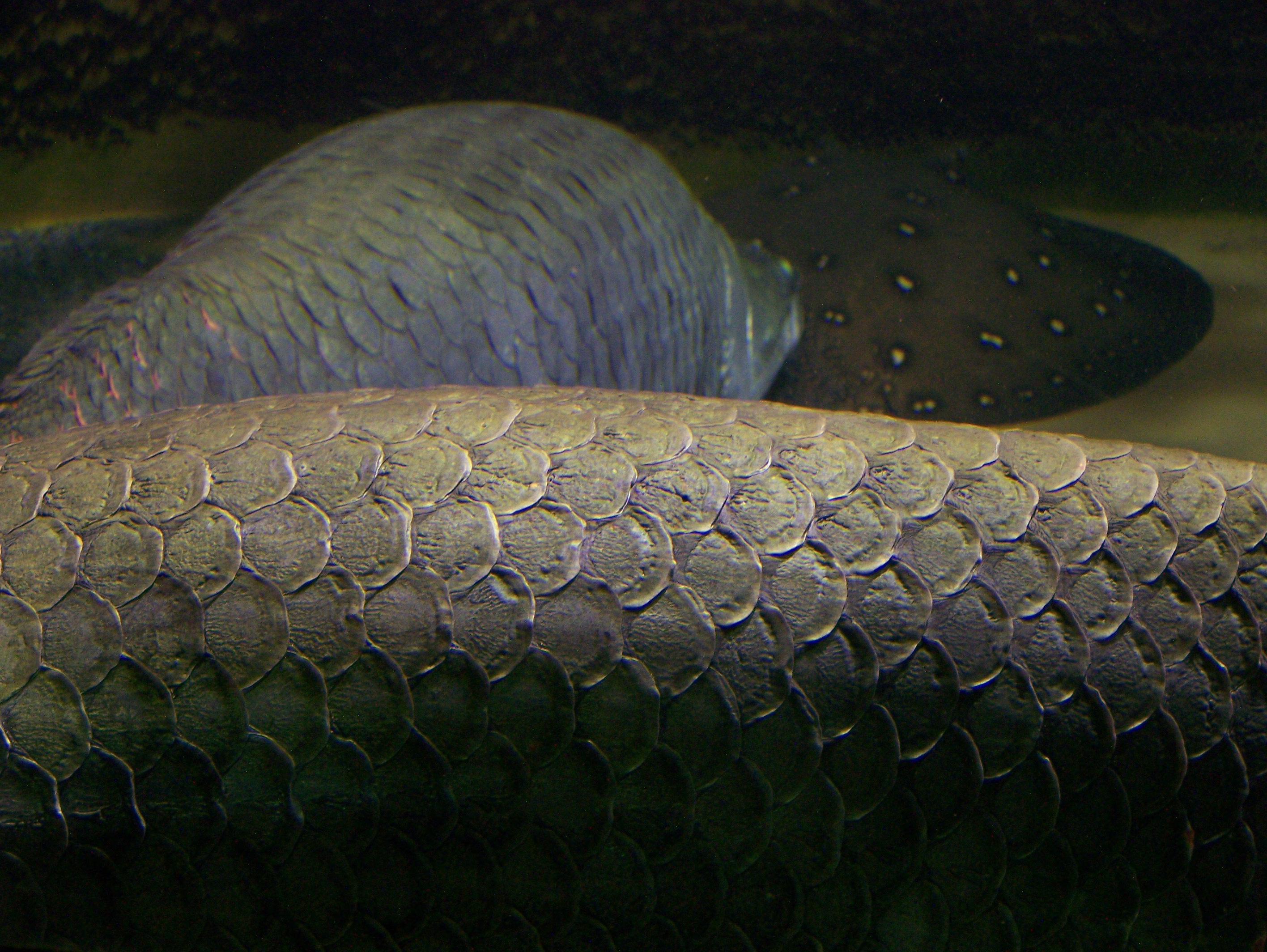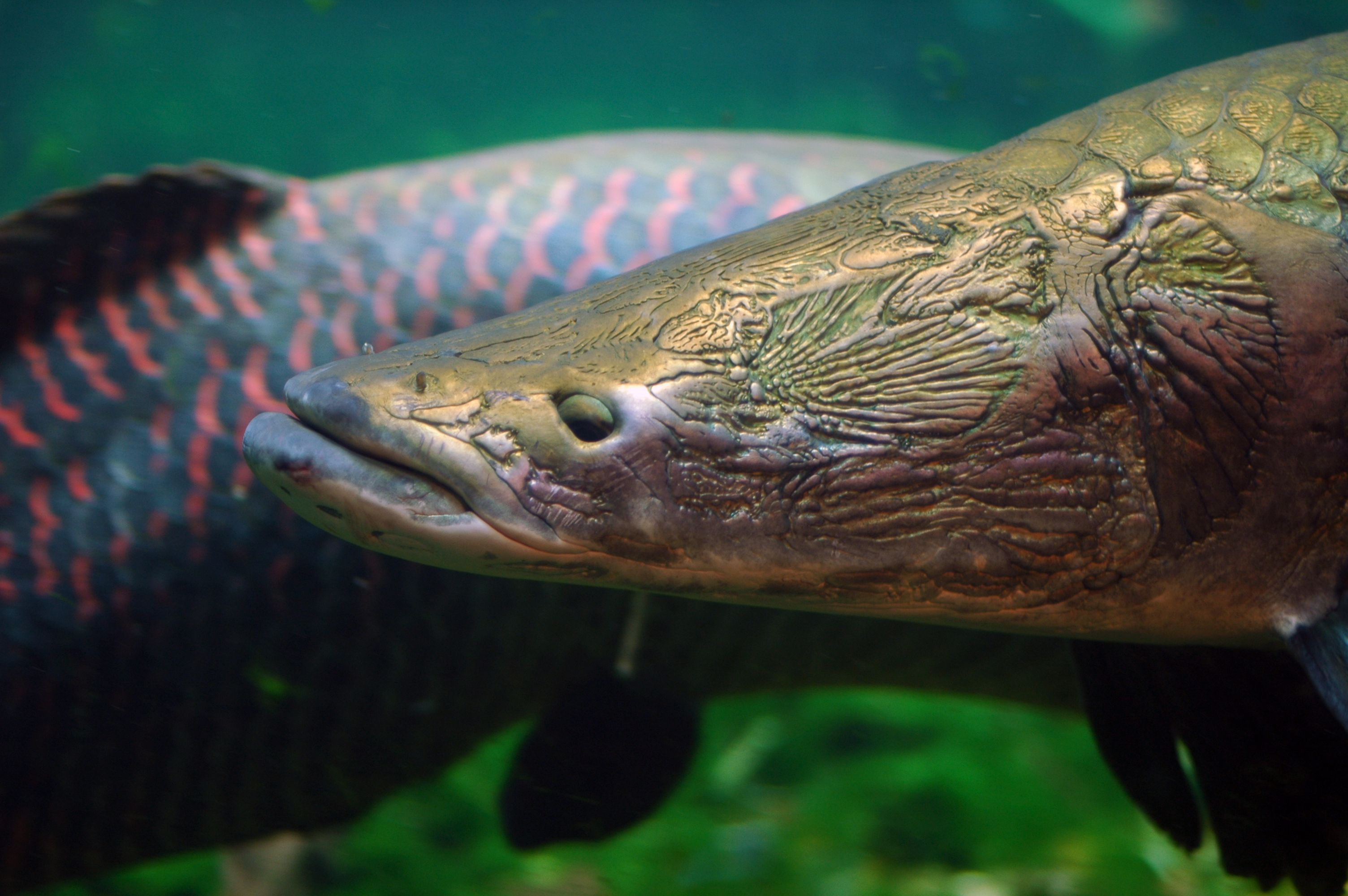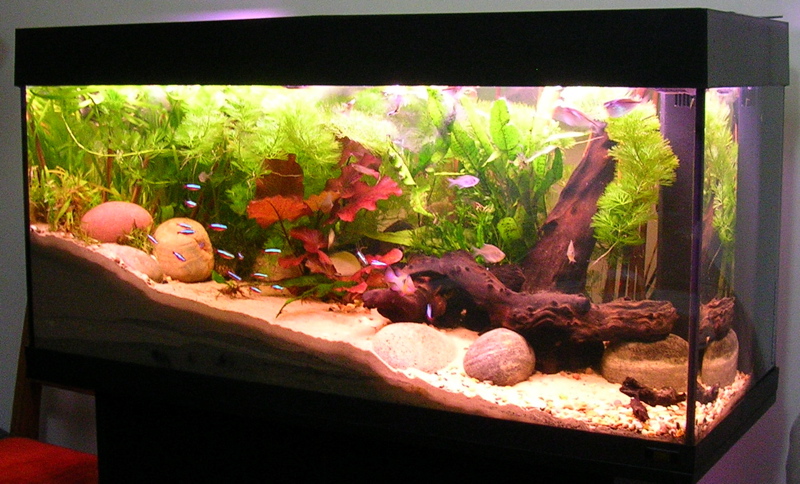|
Arapaima (genus)
The arapaima, pirarucu, or paiche is any large species of bonytongue in the genus ''Arapaima'' native to the Amazon and Essequibo basins of South America. ''Arapaima'' is the type genus of the subfamily Arapaiminae within the family Osteoglossidae.Castello, L.; and Stewart, D.J (2008). Assessing CITES non-detriment findings procedures for Arapaima in Brazil.' NDF Workshop case studies (Mexico 2008), WG 8 – Fishes, Case study 1 They are among the world's largest freshwater fish, reaching as much as in length. They are an important food fish. They have declined in the native range due to overfishing and habitat loss. In contrast, arapaima have been introduced to several tropical regions outside the native range (within South America and elsewhere), where they are sometimes considered invasive species. In Kerala, India, arapaima escaped from aquaculture ponds after floods in 2018. Its Portuguese name, ''pirarucu'', derives from the Tupi language words ''pira'' and ''urucum'', me ... [...More Info...] [...Related Items...] OR: [Wikipedia] [Google] [Baidu] |
Johannes Peter Müller
Johannes Peter Müller (14 July 1801 – 28 April 1858) was a German physiologist, comparative anatomy, comparative anatomist, ichthyology, ichthyologist, and herpetology, herpetologist, known not only for his discoveries but also for his ability to synthesize knowledge. The paramesonephric duct (Müllerian duct) was named in his honor. Life Early years and education Müller was born in Koblenz, Coblenz. He was the son of a poor shoemaker, and was about to be apprenticed to a saddler when his talents attracted the attention of his teacher, and he prepared himself to become a Roman Catholic Priest. During his Secondary school, college course in Koblenz, he devoted himself to the classics and made his own translations of Aristotle. At first, his intention was to become a priest. When he was eighteen, his love for natural science became dominant, and he turned to medicine, entering the University of Bonn in 1819. There he received his Doctor of Medicine, M.D. in 1822. He then studie ... [...More Info...] [...Related Items...] OR: [Wikipedia] [Google] [Baidu] |
Portuguese Language
Portuguese ( or, in full, ) is a western Romance language of the Indo-European language family, originating in the Iberian Peninsula of Europe. It is an official language of Portugal, Brazil, Cape Verde, Angola, Mozambique, Guinea-Bissau and São Tomé and Príncipe, while having co-official language status in East Timor, Equatorial Guinea, and Macau. A Portuguese-speaking person or nation is referred to as " Lusophone" (). As the result of expansion during colonial times, a cultural presence of Portuguese speakers is also found around the world. Portuguese is part of the Ibero-Romance group that evolved from several dialects of Vulgar Latin in the medieval Kingdom of Galicia and the County of Portugal, and has kept some Celtic phonology in its lexicon. With approximately 250 million native speakers and 24 million L2 (second language) speakers, Portuguese has approximately 274 million total speakers. It is usually listed as the sixth-most spoken language, the third-most sp ... [...More Info...] [...Related Items...] OR: [Wikipedia] [Google] [Baidu] |
Arapaima Agassizii
The arapaima, pirarucu, or paiche is any large species of bonytongue in the genus ''Arapaima'' native to the Amazon and Essequibo basins of South America. ''Arapaima'' is the type genus of the subfamily Arapaiminae within the family Osteoglossidae.Castello, L.; and Stewart, D.J (2008). Assessing CITES non-detriment findings procedures for Arapaima in Brazil.' NDF Workshop case studies (Mexico 2008), WG 8 – Fishes, Case study 1 They are among the world's largest freshwater fish, reaching as much as in length. They are an important food fish. They have declined in the native range due to overfishing and habitat loss. In contrast, arapaima have been introduced to several tropical regions outside the native range (within South America and elsewhere), where they are sometimes considered invasive species. In Kerala, India, arapaima escaped from aquaculture ponds after floods in 2018. Its Portuguese name, ''pirarucu'', derives from the Tupi language words ''pira'' and ''urucum'', m ... [...More Info...] [...Related Items...] OR: [Wikipedia] [Google] [Baidu] |
Achille Valenciennes
Achille Valenciennes (9 August 1794 – 13 April 1865) was a French zoologist. Valenciennes was born in Paris, and studied under Georges Cuvier. His study of parasitic worms in humans made an important contribution to the study of parasitology. He also carried out diverse systematic classifications, linking fossil and current species. He worked with Cuvier on the 22-volume "'' Histoire Naturelle des Poissons''" (Natural History of Fish) (1828–1848), carrying on alone after Cuvier died in 1832. In 1832, he succeeded Henri Marie Ducrotay de Blainville (1777–1850) as chair of ''Histoire naturelle des mollusques, des vers et des zoophytes'' at the Muséum national d'histoire naturelle. Early in his career, he was given the task of classifying animals described by Alexander von Humboldt (1769–1859) during his travels in the American tropics (1799 to 1803), and a lasting friendship was established between the two men. He is the binomial authority for many species of fish, such a ... [...More Info...] [...Related Items...] OR: [Wikipedia] [Google] [Baidu] |
Arapaima Arapaima
The arapaima, pirarucu, or paiche is any large species of bonytongue in the genus ''Arapaima'' native to the Amazon and Essequibo basins of South America. ''Arapaima'' is the type genus of the subfamily Arapaiminae within the family Osteoglossidae.Castello, L.; and Stewart, D.J (2008). Assessing CITES non-detriment findings procedures for Arapaima in Brazil.' NDF Workshop case studies (Mexico 2008), WG 8 – Fishes, Case study 1 They are among the world's largest freshwater fish, reaching as much as in length. They are an important food fish. They have declined in the native range due to overfishing and habitat loss. In contrast, arapaima have been introduced to several tropical regions outside the native range (within South America and elsewhere), where they are sometimes considered invasive species. In Kerala, India, arapaima escaped from aquaculture ponds after floods in 2018. Its Portuguese name, ''pirarucu'', derives from the Tupi language words ''pira'' and ''urucum'', m ... [...More Info...] [...Related Items...] OR: [Wikipedia] [Google] [Baidu] |
Species
In biology, a species is the basic unit of classification and a taxonomic rank of an organism, as well as a unit of biodiversity. A species is often defined as the largest group of organisms in which any two individuals of the appropriate sexes or mating types can produce fertile offspring, typically by sexual reproduction. Other ways of defining species include their karyotype, DNA sequence, morphology, behaviour or ecological niche. In addition, paleontologists use the concept of the chronospecies since fossil reproduction cannot be examined. The most recent rigorous estimate for the total number of species of eukaryotes is between 8 and 8.7 million. However, only about 14% of these had been described by 2011. All species (except viruses) are given a two-part name, a "binomial". The first part of a binomial is the genus to which the species belongs. The second part is called the specific name or the specific epithet (in botanical nomenclature, also sometimes i ... [...More Info...] [...Related Items...] OR: [Wikipedia] [Google] [Baidu] |
FishBase
FishBase is a global species database of fish species (specifically finfish). It is the largest and most extensively accessed online database on adult finfish on the web.Marine Fellow: Rainer Froese ''Pew Environment Group''. Over time it has "evolved into a dynamic and versatile ecological tool" that is widely cited in scholarly publications. FishBase provides comprehensive species data, including information on , geographical distribution, and |
World War II
World War II or the Second World War, often abbreviated as WWII or WW2, was a world war that lasted from 1939 to 1945. It involved the vast majority of the world's countries—including all of the great powers—forming two opposing military alliances: the Allies and the Axis powers. World War II was a total war that directly involved more than 100 million personnel from more than 30 countries. The major participants in the war threw their entire economic, industrial, and scientific capabilities behind the war effort, blurring the distinction between civilian and military resources. Aircraft played a major role in the conflict, enabling the strategic bombing of population centres and deploying the only two nuclear weapons ever used in war. World War II was by far the deadliest conflict in human history; it resulted in 70 to 85 million fatalities, mostly among civilians. Tens of millions died due to genocides (including the Holocaust), starvation, ma ... [...More Info...] [...Related Items...] OR: [Wikipedia] [Google] [Baidu] |
Type Specimen
In biology, a type is a particular wiktionary:en:specimen, specimen (or in some cases a group of specimens) of an organism to which the scientific name of that organism is formally attached. In other words, a type is an example that serves to anchor or centralizes the defining features of that particular taxon. In older usage (pre-1900 in botany), a type was a taxon rather than a specimen. A taxon is a scientifically named grouping of organisms with other like organisms, a set (mathematics), set that includes some organisms and excludes others, based on a detailed published description (for example a species description) and on the provision of type material, which is usually available to scientists for examination in a major museum research collection, or similar institution. Type specimen According to a precise set of rules laid down in the International Code of Zoological Nomenclature (ICZN) and the International Code of Nomenclature for algae, fungi, and plants (ICN), the ... [...More Info...] [...Related Items...] OR: [Wikipedia] [Google] [Baidu] |
Aquarium Trade
Fishkeeping is a popular hobby, practiced by aquarists, concerned with keeping fish in a home aquarium or garden pond. There is also a piscicultural fishkeeping industry, serving as a branch of agriculture. Origins of fishkeeping Fish have been raised as food in pools and ponds for thousands of years. Brightly colored or tame specimens of fish in these pools have sometimes been valued as pets rather than food. Many cultures, ancient and modern, have kept fish for both functional and decorative purposes. Ancient Sumerians kept wild-caught fish in ponds, before preparing them for meals. Depictions of the sacred fish of Oxyrhynchus kept in captivity in rectangular temple pools have been found in ancient Egyptian art. Similarly, Asia has experienced a long history of stocking rice paddies with freshwater fish suitable for eating, including various types of catfish and cyprinid. Selective breeding of carp into today's popular and completely domesticated koi and fancy goldfish be ... [...More Info...] [...Related Items...] OR: [Wikipedia] [Google] [Baidu] |
Biological Specimen
A biological specimen (also called a biospecimen) is a biological laboratory specimen held by a biorepository for research. Such a specimen would be taken by sampling so as to be representative of any other specimen taken from the source of the specimen. When biological specimens are stored, ideally they remain equivalent to freshly-collected specimens for the purposes of research. Human biological specimens are stored in a type of biorepository called a biobank, and the science of preserving biological specimens is most active in the field of biobanking. Quality control Setting broad standards for quality of biological specimens was initially an underdeveloped aspect of biobank growth. There is currently discussion on what standards should be in place and who should manage those standards. Since many organizations set their own standards and since biobanks are necessarily used by multiple organizations and typically are driven towards expansion, the harmonization of standard ... [...More Info...] [...Related Items...] OR: [Wikipedia] [Google] [Baidu] |
Taxonomy (biology)
In biology, taxonomy () is the scientific study of naming, defining ( circumscribing) and classifying groups of biological organisms based on shared characteristics. Organisms are grouped into taxa (singular: taxon) and these groups are given a taxonomic rank; groups of a given rank can be aggregated to form a more inclusive group of higher rank, thus creating a taxonomic hierarchy. The principal ranks in modern use are domain, kingdom, phylum (''division'' is sometimes used in botany in place of ''phylum''), class, order, family, genus, and species. The Swedish botanist Carl Linnaeus is regarded as the founder of the current system of taxonomy, as he developed a ranked system known as Linnaean taxonomy for categorizing organisms and binomial nomenclature for naming organisms. With advances in the theory, data and analytical technology of biological systematics, the Linnaean system has transformed into a system of modern biological classification intended to reflect the evolu ... [...More Info...] [...Related Items...] OR: [Wikipedia] [Google] [Baidu] |






.jpg)


